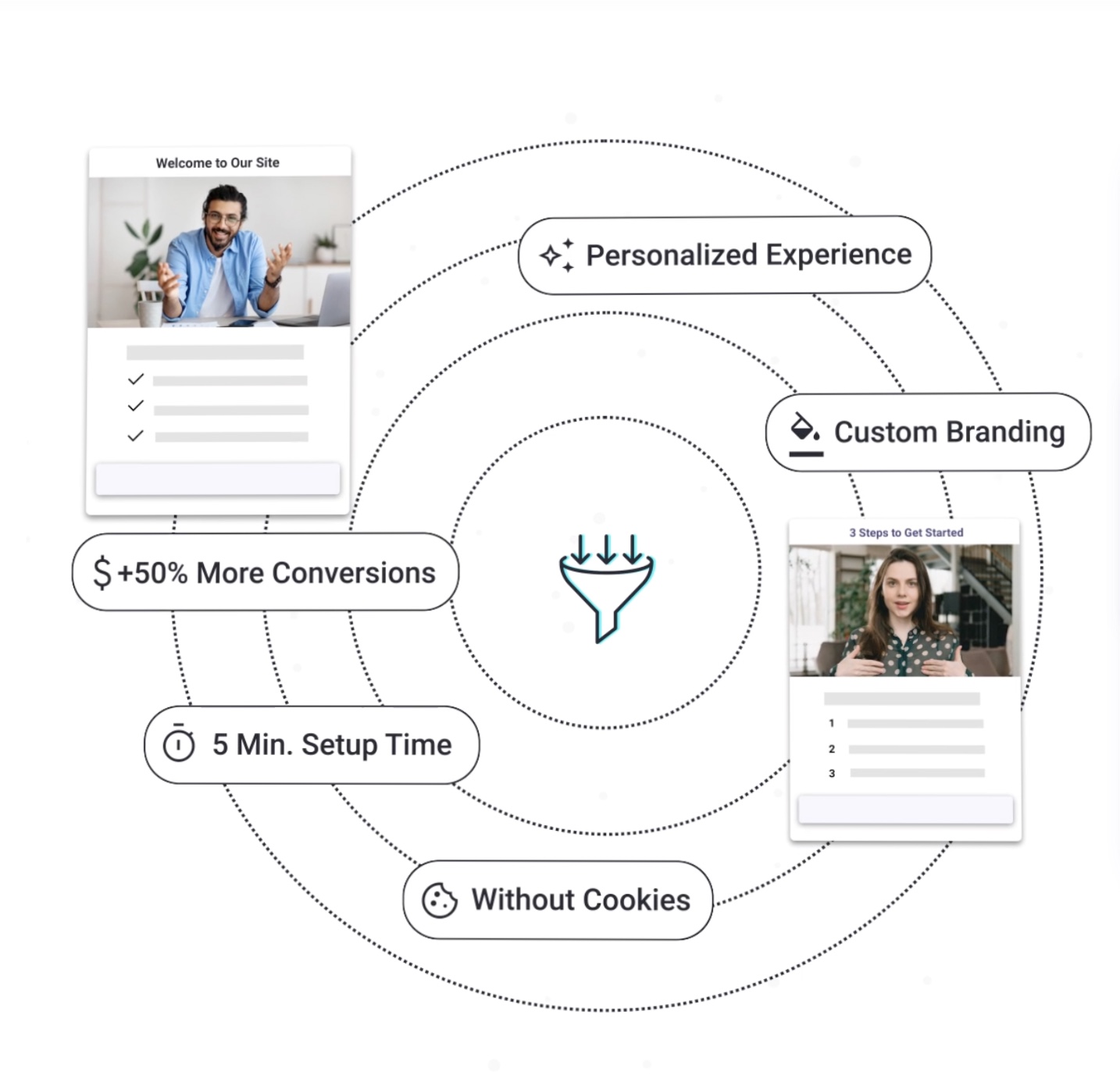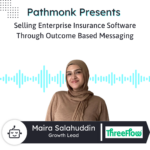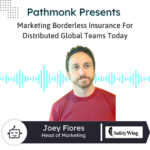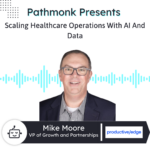
Introduction
Join us as we welcome Arthur Guiot, AI Marketing Senior Consultant at Upthrust, a digital accelerator for SMEs and larger companies.
In this enlightening episode, Arthur shares insights on how Upthrust is revolutionizing marketing for traditional industries by introducing growth marketing techniques and leveraging AI. He discusses innovative approaches to B2B lead generation, the power of webinars, and unconventional advertising strategies that yield impressive results. Arthur also offers valuable productivity tips for marketers in the AI age and emphasizes the importance of sustainable marketing practices.
Discover how AI is reshaping the marketing landscape and learn actionable strategies to boost your B2B marketing efforts.
More Sales From Your Website With AI
Personalized interactions based on your users' behaviour to get +50% more conversions.

Ernesto Quezada: Pathmonk is the intelligent tool for website lead generation. With increasing online competition, over 98% of website visitors don’t convert. The ability to successfully show your value proposition and support visitors in their buying journey separates you from the competition online. Pathmonk qualifies and converts leads on your website by figuring out where they are in the buying journey and influencing them in key decision moments. With relevant micro-experiences like case studies, intro videos, and much more, stay relevant to your visitors and increase conversions by 50%. Add Pathmonk to your website in seconds. Let the AI do all the work and get access to 50% more qualified leads while you keep doing marketing and sales as usual. Check us out on pathmonk.com. Welcome to today’s episode. Let’s talk about today’s guest. We have Arthur from Upthrust, AI marketing senior consultant with them. How are you doing today, Arthur?
Arthur Guiot: I’m very good, very long day and looking forward to discussing a bit of marketing and AI with you.
Ernesto: Definitely interesting, right? You’re an AI marketing senior consultant. We’re an AI company. So interesting to have you on with us today.
Arthur: It’s a Tinder match, it seems like.
Ernesto: Exactly. Thank you. Well, let’s kick it off, right? I’m sure, Arthur, our listeners are tuning in and wondering what Upthrust is all about. So in your own words, tell us a little bit more.
Arthur: It’s a digital accelerator, mostly for SMEs and larger companies, located in Belgium, in this case in Antwerp. We help large companies to implement growth marketing into their current marketing and customer support. What’s happening is that when you deal with insurances, finance, you have a lot of corporate mindsets and old traditions of doing marketing, and they have huge websites. It’s true that sometimes it’s quite interesting to bring new ways of working more from the startup world, from the techie world, to shake things up. And that’s what we do. What happened differently is that two years ago when ChatGPT was released, directly because we used to do SEO, advertisement, conversion rate optimization, etc., we started to realize that, wow, this is big, it’s definitely going to change the way we work. And let’s say that I dove into it and started to replace every task that I used to do. At that moment, I was like, okay, it writes better copies than me, it makes better hooks, it makes better newsletters. And then we started to automate this to scale, and that’s where we are today.
Ernesto: That’s awesome to hear. Right. I think that’s a nice way of AI helping everybody out a little bit better every chance and just automating. That’s just great to have. And so that way our listeners could get a good understanding there, Arthur, of Upthrust. Then what would you say is that key problem that you guys like to solve for clients?
Arthur: I would not say creativity or those kinds of things because when we go to the marketing department, they already have good skills, good people, and people quite techie as well. What I realize is that sometimes they have a lot of initiatives, but they have such a huge infrastructure, old IT department, so many roles and procedures to follow. You will see that a lot of larger companies are kind of stuck. So you have people who have ideas, they want to provide a different email flow for the customer, they want to create a chatbot, etc. But you have such a huge infrastructure on top that, in the end, nothing happens. It’s just about politics. What’s interesting with the agency where I work is that we come as externals, and using external tools, third-party tools, etc., we can really try to experiment with things in a really short time frame, three months, four months, to make a use case and come back to the CFO with something like, “Hey, look, this is working. Using a chatbot to convert people on that specific e-com makes sense. We should go for it.” And then all the politics start to be a bit smoother, I guess.
Ernesto: Okay, great to hear that from you. So then, is there a certain vertical segment that you guys like to go for? Is there an ideal ICP for Upthrust?
Arthur: I would say it’s really bad to say a segment based on revenue, but companies making more than 5 million. Sometimes it’s about the maturity of the marketing department. What I mean by that is sometimes you have large companies that make a lot of revenue, but marketing-wise, they are not super mature yet. They haven’t tried a lot of things, and we are going to thrive, but we will thrive even more if they are already set up. Everything is rolling, and they just want to scale and grow there. That’s really where we thrive the most.
Ernesto: Okay, perfect. Awesome. Great to hear that. So what would you say then, is a top client acquisition channel for Upthrust?
Arthur: Top based on CPL, based on return investment. What’s the best according to…? I will divide a bit. In terms of acquisition, I would say that the most interesting from our side is we have a huge network. We belong to a group, and this group has a lot of different agencies, and those agencies have their own contacts. It seems like one agency doing strategic consultancy is like a huge leads provider. Why? Because you often have people taking key decision roles there, and as soon as they see an opportunity, or we could experiment with something, they are going to bring the opportunity to Upthrust. But once again, that’s more like network and word of mouth.
What I could say is that in terms of acquisition channels, webinars work a lot. We do one webinar, I guess, every two weeks or three weeks, something like this. What’s super interesting about webinars is that we have quite a lot of senior consultants. So they could give a webinar with 1-hour preparation, show the time to make the slides, and we are quite good with advertisements. Within one month, we have all ads for the webinar, we have all slide decks, and we just roll. And because we learned to automate all sequences like this, usually we often end up with a CPL of €20 for B2B, and out of 400, 500 participants, we might do like, I don’t know, 5,000–10,000 euros of deals, something like this. So it’s not negligible. Outside of the webinars and LinkedIn ads, I would say that we have an academy as well. So what does it do exactly? It proposes marketers to learn about growth marketing and the latest tools like Pathmonk, Google Analytics, Adobe Analytics, etc. And what’s happening is that you will have companies that are going to send us their employees to train them. But the thing is that the employees will often realize that they cannot do it alone. They need, like, “Okay, I really want to implement this Google Ads campaign, etc. How can I do this? How do I need to convince my manager?” And then they bring the manager into the conversation. And actually, it’s quite a big pipeline for us as well.
Ernesto: Okay. Awesome. Talking about some campaigns that drive traffic, what role does the website play in this case? For our listeners to check you guys out, they could check you out at upthrust.eu. What role does the website play in client acquisition?
Arthur: I would be a bad Pathmonk segmentation there. But our website is not on point at the moment. We have this quote in French, which says that the child of the shoemaker always has the cheapest shoes, and I guess the same goes for us. What does it mean? It means that we haven’t updated our website for like two years or something. We know that something should be updated at least every two months. So what’s happening is that we use a lot of landing pages. We use a program called Unbounce. So every new webinar, every new campaign goes to one specific landing page. So in the end, we don’t use the website that much. We use mostly LPs, which are totally customized based on the campaign that we are running.
Ernesto: Definitely. Okay. So then is there any tools or tips or methods that you would recommend to our listeners as far as some website lead generation?
Arthur: Regarding advertisement or regarding conversion rate on landing pages?
Ernesto: Advertising.
Arthur: Okay. For B2B. B2B or B2C e-com because it might totally differ, right?
Ernesto: Yeah, I mean, let’s go B2B. Right. I think that’s one of the hardest.
Arthur: So what we have seen, and this is sometimes counterintuitive, is that when you are dealing with advertisements, you have the impression, okay, this channel goes for that type of audience. So I will stick with it. Typically, if you work in insurance and you are looking for other brokers, you will think, okay, brokers are on LinkedIn. So I will do advertisements on LinkedIn, or you will do YouTube advertisements targeting channels where only brokers would subscribe. By experience, it seems that those kinds of targeting actually, first, are super expensive in Europe at least, and second, the conversion rate CTR is super, super low. Why? Because if you start doing one specific campaign only targeting only the brokers of Bristol, of Iris, or whatsoever, you will realize that your cost per thousand of views of impression is super, super high. Plus, those brokers, when they arrive on LinkedIn, you know, for networking or something, they don’t care about your solution. So the probability for them to click, etc. is quite low compared to channels that are a bit more popular, like TikTok, Instagram, Spotify ads. Even if it seems quite weird, you will see that the conversion rate on those channels is still super high. And that, by the way, you do your videos, the way you do your content, and the way you write your copy, it’s already the biggest filter. If you start your copy like, “Hey brokers, are you interested in this insurance?” and those kinds of things, and then your video is just a short 20 seconds showing like why this insurance is cool and quickly in 10 seconds, and the rest of 10 seconds just shows how to get there. It seems that it has the highest conversion value for B2B, even if it’s counterintuitive. Another thing that I can add, because we do it a lot at Upthrust, is user-generated content. Typically, I will take my phone: “Hello, I’m a broker working in BlackRock. I really like what I’m doing. And if you need any financial insurances, check out this link. They are amazing. Cheers, guys.” 15 seconds. And what’s important is that the person making the video is the most natural as possible. So, for example, here I’m in my apartment. It seems legit, like you have a disorderly kitchen, someone working hard, and these kinds of things. And so people can relate, and other brokers can relate, and if they can relate, they feel it’s for them. And if they feel it’s for them, you get more interest and sometimes more clicks and conversions as well.
Ernesto: Definitely. Okay, awesome to hear that. Well, let’s switch gears a little bit then, Arthur, and let’s talk about you as a leader. I mean, like you’ve been mentioning, right? You are the AI marketing consultant there for Upthrust. What are some key tasks you like to focus on in your day-to-day work?
Arthur: It’s interesting. As a marketer, we use a lot of different tools. We are connected all the time. It can be on Teams, Slack, Discord. You get information everywhere. And something that I do every morning after writing all the to-dos, I will spend like 1 hour or something like this just writing in advance very, very long prompts. So I write myself. Let’s take the example of this podcast. At 08:00 a.m., I will start. “Okay, I need to create a script for this podcast because I want my podcast to be structured,” etc. At 08:10, what I will do totally offline, with the Wi-Fi off, on a simple Word document, I will spend time writing precisely a prompt. What do I need for that script? Like, “Okay, I want this script to be structured like this. I want to say this, I want this, I want this.” And I create a really large prompt, sometimes like 1000 characters or something. And I do that for every one of my tasks. So if I have a task like preparing this meeting, boom, I’ve got a prompt for preparing this meeting. If I have a task like creating copies for that client, I would have the prompt for this. Next step, you can imagine instead of just using ChatGPT, I have a tool that is going to open like five different language models. I’m just going to prompt, and then it starts like this. So once you have like five or six different outputs, you take the best, and you start the task. So you have the output as a text, sometimes as a PowerPoint, sometimes it’s an image, etc., and you start the task like, “Okay, my script. This is the output that I would like for my script now.” I would put that on a Google sheet, or I would put that in an email, I would send it to you, etc. And it’s stupid, but working like this really improved my productivity by 10% to 20% every day. So, a little trick for everybody.
Ernesto: That’s definitely something great there. All right, awesome. Well, let’s jump into our next section then here, Arthur, which is our rapid-fire question round. Are you ready for them?
Arthur: Let’s go.
Ernesto: All right, awesome. First up then, Arthur, is what is the last book that you read?
Arthur: The last book, I’m reading right now is “Productivity Ninja.” So what is it about? There is David Allen’s “How to Get Things Done,” and it’s like a new version of it, more focused on tech and updated in 2024, let’s say.
Ernesto: Okay, great read there for our listeners. Next up then, is, if there were no boundaries in technology, what would be that one thing that you would want to have fixed for your role as a marketer today?
Arthur: Sustainability. I know it’s weird, but deep inside, I’m still green-minded, or at least I want my kids to survive this. And as a marketer, sometimes we feel ashamed of what we are doing. What do I mean? Spending €10,000 on Facebook ads, that’s five planes, Chicago to Paris. Just prompting on ChatGPT, I don’t have the numbers, so don’t fact-check this, but I think it’s like 5 hours of electricity, something like this. And it’s true that you have the impression that the more you work, actually, the more impact it has on the environment, and we’re crazy if we find a way to reduce or to have free energy for that.
Ernesto: Okay, awesome. Great to hear that. Lastly, Arthur, I mean, you have a lot of experience already in the marketing world, but what is that one piece of advice that you would give yourself if you were to restart your journey as a marketer today?
Arthur: Document everything that you experiment. It’s something that I lost, certainly, with time. But I recently found back my Pinterest board, and there I had like 50 different boards, like interior design ideas, new keyboards, copywriting ideas, I think. And I was so impressed by how I kept everything structured and everything, and right now I’m reaching my eight years as a consultant. And I believe that in eight years, every piece of idea, every new cool link or image that I had, I had a kind of way to structure them and find them back. I would have such an amazing database. So, yeah, I would have still restarted there, definitely.
Ernesto: All right. Some great advice there for the ones that are starting. Right? Awesome. Arthur, hey. Well, Arthur, it’s been a pleasure to have had you on our show today. But before we end, I do want to give you the last word. Say someone forgets everything about the interview today. What is that one thing they should remember about Upthrust?
Arthur: AI is not going to replace your job. Growth marketing is awesome. And don’t forget, if it doesn’t convert, it’s not the fault of the users. It’s certainly yours.
Ernesto: Definitely important. All right, awesome. Hey. Well, Arthur, I do want to thank you for being on with us today. To our listeners, I wanted to thank you for tuning in, and I’m looking forward to our next episode at Pathmonk Presents. Thanks a lot, Arthur.
Arthur: Thanks. Good evening, everybody.











